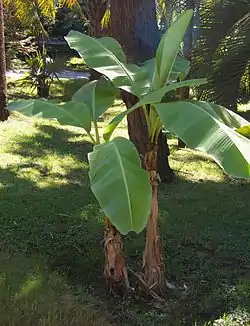Musa basjoo
Musa basjoo, known variously as Japanese banana,[1] Japanese fibre banana[2] or hardy banana, is a species belonging to the genus Musa. It was previously thought to have originated in the Ryukyu islands of southern Japan, from where it was first described in cultivation,[3] but is now known to have originated in subtropical southern China, where it is also widely cultivated, with wild populations found in Sichuan province.[2][4]
| Musa basjoo | |
|---|---|
 | |
| Scientific classification | |
| Kingdom: | Plantae |
| Clade: | Tracheophytes |
| Clade: | Angiosperms |
| Clade: | Monocots |
| Clade: | Commelinids |
| Order: | Zingiberales |
| Family: | Musaceae |
| Genus: | Musa |
| Section: | Musa sect. Musa |
| Species: | M. basjoo |
| Binomial name | |
| Musa basjoo Siebold & Zucc. ex Iinuma | |
Description
Musa basjoo is a herbaceous perennial with trunk-like pseudostems[lower-alpha 1] growing to around 2–2.5 m (6.6–8.2 ft), with a crown of mid-green leaves growing up to 2 m (6.6 ft) long and 70 cm (28 in) wide when mature. The species produces male and female flowers on the same inflorescence which may extend for over 1 m (3.3 ft). The banana fruit formed are yellow-green, around 5–10 cm (2.0–3.9 in) long and 2–3 cm (0.79–1.18 in) broad; they are inedible, with sparse white pulp and many black seeds.[3][5]
Uses
Cultivation
Musa basjoo has been cultivated both for its fibre and as an ornamental plant in gardens outside its natural range, first in Japan, and from the late 19th century, then in the warmer parts of western Europe (north to Britain), the United States, and southern Canada. In gardens, it is used as a hardy 'tropical foliage' plant. Although the pseudostem may only cope with a few degrees below freezing, the underground rhizome is considered frost hardy, if well insulated with thick mulch, in areas with winter temperatures down to −12 °C (10 °F).[3][6] The roots are considered hardy to −10 °C (14 °F).[7] If the pseudostem is killed, the banana will resprout from the ground where it rapidly grows to full size in a season under optimal conditions. Thus, it can be grown as far north as USDA zone 6a. It can also be overwintered undercover in a pot and kept growing, which is the only way it can be made to fruit in northern regions as it requires 12–24 months of warmth to bloom.[3]
In the UK it has gained the Royal Horticultural Society’s Award of Garden Merit.[8][9]
Fibre
In Japan, Musa basjoo plant fibres are used to produce textiles known in Japanese as kijōka-bashōfu (bashōfu 芭蕉布, lit. "banana cloth"). Whole pseudostems are cut into strips up to 3 m long. These are beaten, bleached and dried to produce the raw material, which can then be made into products like hand-knotted carpets, tablecloths, kimono and paper.[7] Outside Japan, Manila hemp is obtained from related plant, Musa textilis, whose unbleached fibres are used for high strength rope.
Traditional medicine
In traditional Chinese medicine, the stem, flower, leaves and rhizome of Musa basjoo are considered useful for clearing heat-toxins, quenching thirst and disinhibiting urine.[10]
Notes
- A pseudostem is a false stem formed by the rolled bases of leaves.
References
| Wikimedia Commons has media related to Musa basjoo. |
| Wikispecies has information related to Musa basjoo. |
- Snow Barlow (July 19, 2002). "Sorting Musa Names". Multilingual Multiscript Plant Name Database. University of Melbourne. Retrieved July 7, 2010.
- "Musa basjoo". Germplasm Resources Information Network (GRIN). Agricultural Research Service (ARS), United States Department of Agriculture (USDA). Retrieved January 10, 2018.
- Huxley, A., ed. (1992). New RHS Dictionary of Gardening 3: 268. Macmillan ISBN 0-333-47494-5.
- Liu, A.-Z.; Li, D.-Z.; Li, X.-W. (2002). "Taxonomic notes on wild bananas (Musa) from China". Bot. Bull. Acad. Sin. 43: 77–81.
- Constantine, D. (1999–2008). "Musa basjoo". The Musaceae: An annotated list of the species of Ensete, Musa and Musella.
- "Banans Raras – Musa basjoo". Retrieved 23 November 2013.
- Wong, James (2013), "Kimonos from banana peel?" (PDF), The Garden, 138 (8): 17
- "RHS Plantfinder - Musa basjoo". Retrieved 4 April 2018.
- "AGM Plants - Ornamental" (PDF). Royal Horticultural Society. July 2017. p. 65. Retrieved 4 April 2018.
- Musa basjoo Sieb. et Zucc.. Medicinal Plant Images Database, School of Chinese Medicine, Hong Kong Baptist University. Retrieved on 25 February 2012.
External links
- Musa basjoo Sieb. et Zucc. Medicinal Plant Images Database (School of Chinese Medicine, Hong Kong Baptist University) (in English) (in Chinese)
